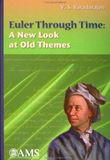Varadaraja V.S. Euler Through Time: A New Look at Old Themes. 2006.
 Varadaraja V.S. Euler Through Time: A New Look at Old Themes. - AMS, 2006. - 302 p.
Varadaraja V.S. Euler Through Time: A New Look at Old Themes. - AMS, 2006. - 302 p.
download (DjVu)
Euler is one of the greatest and most prolific mathematicians of all time. He wrote the first accessible books on calculus, created the theory of circular functions, and discovered new areas of research such as elliptic integrals, the calculus of variations, graph theory, divergent series, and so on. It took hundreds of years for his successors to develop in full the theories he began, and some of his themes are still at the center of today's mathematics. It is of great interest therefore to examine his work and its relation to current mathematics. This book attempts to do that. In number theory the discoveries he made empirically would require for their eventual understanding such sophisticated developments as the reciprocity laws and class field theory. His pioneering work on elliptic integrals is the precursor of the modern theory of abelian functions and abelian integrals. His evaluation of zeta and multizeta values is not only a fantastic and exciting story but very relevant to us, because they are at the confluence of much research in algebraic geometry and number theory today (Chapters 2 and 3 of the book). Anticipating his successors by more than a century, Euler created a theory of summation of series that do not converge in the traditional manner. Chapter 5 of the book treats the progression of ideas regarding divergent series from Euler to many parts of modern analysis and quantum physics. The last chapter contains a brief treatment of Euler products. Euler discovered the product formula over the primes for the zeta function as well as for a small number of what are now called Dirichlet $L$-functions. Here the book goes into the development of the theory of such Euler products and the role they play in number theory, thus offering the reader a glimpse of current developments (the Langlands program).

